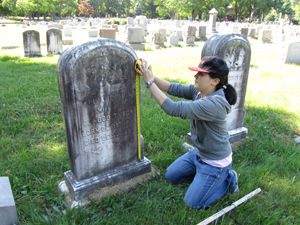Megan Kawamoto is spending her summer not on the beach or by the pool, but in a cemetery. The sophomore engineering major has teamed up with Associate Professor of Earth Sciences Laura Guertin to study marble gravestones to uncover hundreds of years' worth of pollution and climate information. Their results will help unearth just how much more pollution is in the air today.
The data is being collected from 57 tombstones at Cumberland Cemetery in Lima, Pa., for the EarthTrek Gravestone Project, which aims to map the location of graveyards around the globe and then use marble gravestones in those graveyards to measure the weathering rate of marble at that location. Once Guertin and Kawamoto finish analyzing their data, they will send it to the global database.
"The weathering rates of gravestones are an indication of changes in the acidity of rainfall between locations and over time," Guertin said. "The acidity is affected by air pollution and other factors, and could be used as a measure of changes in climate and pollution levels."
Every time it rains, the raindrops contain more than just water, she explained. As well as the small particles of dust that the water drops form around, the water can contain chemicals found in the atmosphere. Often the rain will end up being slightly acidic. This "acid" rain can then chemically affect (weather) materials with which it comes in contact. The amount of weathering that occurs from place to place differs and may be changing over time.
Marble is a common stone used to make gravestones and is mostly made up of the mineral calcite. Calcite is a carbonate mineral, and so it reacts with any acid, including the weak rainfall acids, and dissolves. This means that over time, marble headstones are slowly weathering away.
Visit http://www.goearthtrek.com/Gravestones/Gravestones.html to learn more about the EarthTrek Gravestone Project.
